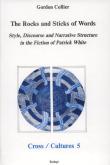 3259068625367100464.png
3259068625367100464.png
 The Rocks and Sticks of Words: Style, Discourse and Narrative Structure in the Fiction of Patrick White
multi chapter work
The Rocks and Sticks of Words: Style, Discourse and Narrative Structure in the Fiction of Patrick White
multi chapter work
 3259068625367100464.png
3259068625367100464.png
 The Rocks and Sticks of Words: Style, Discourse and Narrative Structure in the Fiction of Patrick White
multi chapter work
The Rocks and Sticks of Words: Style, Discourse and Narrative Structure in the Fiction of Patrick White
multi chapter work
'The Australian Novelist Patrick White (1912-1990) is celebrated for the breadth and profundity of his vision of man and for the epic implications of his thematic concerns: the award of the Nobel Prize for Literature in 1973 was one reflection of these directions in critical interest. At the same time, consideration of White's work has frequently been characterized by a "schizophrenic" attitude (overt or subliminal) towards those aspects of his art by which he himself laid greatest store: the mode of storytelling. White is too often held to be a "mannered" and "idiosyncratic" writer, a pretentious and even clumsy stylist with a predilection for authorial intrusiveness. In this study, original techniques of linguistic and narrative analysis are brought to bear on White's remarkable style, in order to call such judgements into question. White's readers and critics, it is argued, are often the victims of their own projections and misplaced assumptions about the nature of narrative process. Attention is also devoted to questions of 'twice-telling" and intertextuality, and a new, "indexical" procedure is suggested for coping with White's techniques of figuration. White's affinities with such writers as Dostoevsky, James and Faulkner are examined contrastively, with a view to classifying him as preeminently a novelist of consciousness, rather than of "character" and "morality". One central novel, The Solid Mandala, is submitted to full-scale analysis: also extensively discussed are The Tree of Man, Riders in the Chariot, and The Twyborn Affair.' (Publication summary)